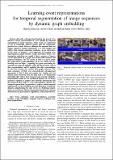Por favor, use este identificador para citar o enlazar a este item:
http://hdl.handle.net/10261/235074COMPARTIR / EXPORTAR:
 SHARE SHARE
 CORE
BASE CORE
BASE
|
|
| Visualizar otros formatos: MARC | Dublin Core | RDF | ORE | MODS | METS | DIDL | DATACITE | |

| Título: | Learning event representations for temporal segmentation of image sequences by dynamic graph embedding |
Autor: | Dimiccoli, Mariella; Wendt, Herwig | Fecha de publicación: | 2020 | Editor: | Institute of Electrical and Electronics Engineers | Citación: | IEEE Transactions on Image Processing 30: 1476-1486 (2020) | Resumen: | Recently, self-supervised learning has proved to be effective to learn representations of events suitable for temporal segmentation in image sequences, where events are understood as sets of temporally adjacent images that are semantically perceived as a whole. However, although this approach does not require expensive manual annotations, it is data hungry and suffers from domain adaptation problems. As an alternative, in this work, we propose a novel approach for learning event representations named Dynamic Graph Embedding (DGE). The assumption underlying our model is that a sequence of images can be represented by a graph that encodes both semantic and temporal similarity. The key novelty of DGE is to learn jointly the graph and its graph embedding. At its core, DGE works by iterating over two steps: 1) updating the graph representing the semantic and temporal similarity of the data based on the current data representation, and 2) updating the data representation to take into account the current data graph structure. The main advantage of DGE over state-of-the-art self-supervised approaches is that it does not require any training set, but instead learns iteratively from the data itself a low-dimensional embedding that reflects their temporal and semantic similarity. Experimental results on two benchmark datasets of real image sequences captured at regular time intervals demonstrate that the proposed DGE leads to event representations effective for temporal segmentation. In particular, it achieves robust temporal segmentation on the EDUBSeg and EDUBSeg-Desc benchmark datasets, outperforming the state of the art. Additional experiments on two Human Motion Segmentation benchmark datasets demonstrate the generalization capabilities of the proposed DGE. | Versión del editor: | http://dx.doi.org/10.1109/TIP.2020.3044448 | URI: | http://hdl.handle.net/10261/235074 | DOI: | 10.1109/TIP.2020.3044448 | Identificadores: | doi: 10.1109/TIP.2020.3044448 issn: 1057-7149 e-issn: 1941-0042 |
| Aparece en las colecciones: | (IRII) Artículos |
Ficheros en este ítem:
| Fichero | Descripción | Tamaño | Formato | |
|---|---|---|---|---|
| 2389-Learning-event-representations-for-temporal-segmentation-of-image-sequences-by-dynamic-graph-embedding.pdf | 4,92 MB | Adobe PDF |  Visualizar/Abrir |
CORE Recommender
Page view(s)
67
checked on 18-abr-2024
Download(s)
65
checked on 18-abr-2024
Google ScholarTM
Check
Altmetric
Altmetric
NOTA: Los ítems de Digital.CSIC están protegidos por copyright, con todos los derechos reservados, a menos que se indique lo contrario.
